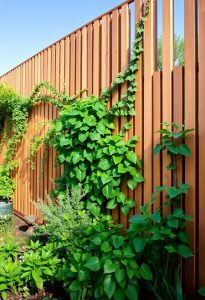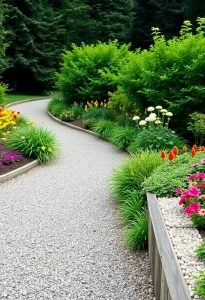When you’re planting in an enclosed garden, think seasonally! In spring, vibrant pansies and snapdragons cheer up your space, while summer’s heat-loving tomatoes and peppers thrive under that warm sun. Don’t forget about fall favorites like kale, and evergreens in winter to keep things lively! Make sure to prep your soil well and monitor light conditions. Have you ever watched a plant flourish because of just the right amount of care? There’s so much to explore on optimizing your garden!
Design Highlights
- Assess sunlight exposure in your enclosed garden to select plants that thrive in full sun or partial shade during each season.
- Choose seasonal plants: vibrant flowers in spring, heat-loving vegetables in summer, cool-weather crops in fall, and evergreens in winter.
- Test and prepare soil with organic compost to ensure ideal pH and drainage for optimal plant growth.
- Monitor and adjust watering practices, using morning irrigation and considering a drip system for efficiency in enclosed spaces.
- Utilize reflective surfaces and strategic plant placement to maximize light exposure for seasonal growth in your garden.
Understanding Your Enclosed Garden Environment
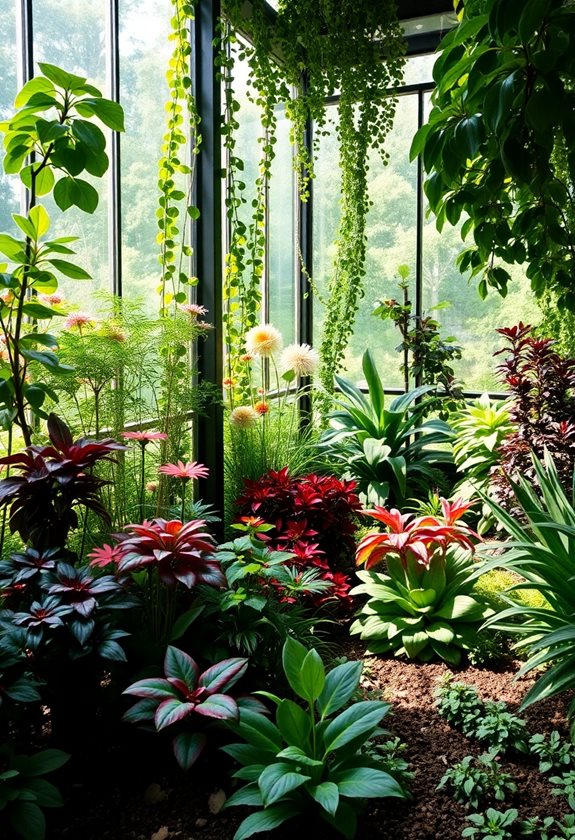
When you step into your enclosed garden, it’s like entering a whole new world, isn’t it? You’ve got a safe space where you can explore nature’s beauty without worrying about the outside elements. First, pay attention to sunlight—does your garden get full sun or partial shade? Next, consider temperature variations; enclosed gardens can trap heat, making it warmer than expected. Don’t forget about wind protection! Strong gusts can damage plants. Finally, think about humidity levels; they can fluctuate greatly. Take this time to observe and understand your unique environment, and you’ll create a thriving, safe sanctuary for your plants! Additionally, incorporating shade-loving plants can help ensure your garden remains vibrant even in lower light conditions.
Choosing the Right Plants for Each Season
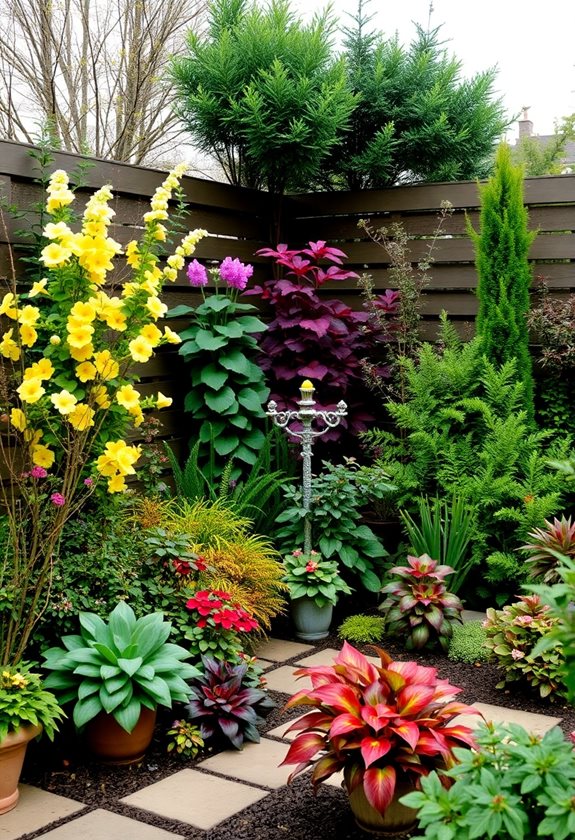
Choosing the right plants for each season can feel like a fun puzzle waiting to be solved! Start by considering what grows best in your climate. In spring, think vibrant flowers like pansies or snapdragons. Summer? Opt for heat-loving veggies like tomatoes and peppers. Come fall, don’t forget about kale or chrysanthemums, which thrive as temperatures drop. And in winter, evergreens can keep your garden looking alive! Remember, safety matters—choose non-toxic plants if you have pets or kids around. Additionally, incorporating lush garden ideas can enhance the beauty and productivity of your small space. So, what combinations will you try? The possibilities are endless, and your enclosed garden’s charm is just a season away!
Soil Preparation and Fertilization Techniques

After you’ve picked out the perfect plants for your enclosed garden, it’s time to roll up your sleeves and get your hands dirty! Start by testing your soil pH—most plants love a slightly acidic to neutral range. Mix in organic compost to enrich the soil, adding nutrients while improving drainage. Don’t forget to wear gloves; no one wants dirty nails! If you’re using fertilizer, choose a slow-release option to avoid overwhelming your plants. And remember, it’s always better to under-fertilize than overdo it. Additionally, consider using organic potting mix to provide a rich and balanced foundation for your plants. Ready to nurture your green friends? Let’s get planting and watch them thrive!
Optimizing Light Conditions for Seasonal Growth

Although enclosed gardens offer a unique opportunity to create your own green sanctuary, optimizing light conditions for your plants can be a bit of a puzzle. Have you ever noticed how some plants thrive while others struggle? It’s all about light! To maximize growth, consider these tips:
- Position your plants based on their light needs; some love full sun, while others prefer shade.
- Use reflective surfaces, like mirrors, to bounce light around.
- Prune nearby trees or shrubs to reduce shading.
Incorporating layering techniques can also help enhance light exposure and create a more dynamic garden environment. Trust me, with a little planning, your plants will bask in their perfect glow, and you’ll enjoy a vibrant garden in no time!
Temperature and Humidity Control Strategies

You’ve got your plants positioned just right to soak up all that lovely light, but what about keeping them cozy in their environment? Controlling temperature and humidity is key!
Creating the perfect environment for your plants means balancing light with cozy temperatures and humidity levels!
- Use thermometers: Regularly check temperatures to guarantee they’re just right.
- Ventilation: Open windows or use fans to prevent stuffiness.
- Humidity trays: A simple tray of water can boost humidity levels; just watch for excess moisture! Additionally, consider investing in essential garden tools that can help maintain optimal conditions for your plants.
Watering Practices for Enclosed Gardens

When it comes to watering your plants, balancing their thirst with the right amount of moisture can feel like a bit of a juggling act, can’t it? To keep your enclosed garden thriving and safe, consider these watering practices:
- Check the soil moisture regularly—stick your finger in the soil to gauge its dryness.
- Water in the morning—this helps prevent mold and keeps plants cool.
- Use a drip irrigation system—it’s efficient and minimizes water waste.
- Adjust based on plant needs—different plants have different thirst levels! Additionally, consider using weather-resistant materials to enhance the longevity of your garden pathways.
With these tips, you’ll nurture a safe, lush oasis in your garden!
Pest Management Solutions for Indoor Plants

While you might think your indoor plants are safe from pesky pests, they can still fall victim to unwanted visitors if you’re not careful. To keep your green friends thriving, start with regular inspections. Look for signs like sticky residue or tiny webs. If you spot trouble, try these solutions:
Indoor plants aren’t immune to pests—regular inspections are key to keeping them safe and thriving!
- Neem oil: A natural repellent that works wonders!
- Soap solution: Mix mild soap and water to spray on affected areas.
- Sticky traps: Catch those sneaky bugs before they spread.
Don’t forget to keep your space clean—pests love clutter! Additionally, creating a serene atmosphere with features like cascading tiers can help improve your indoor environment, making it less inviting for pests. Have you ever had a surprise infestation? It’s not fun, trust me!
Seasonal Maintenance Tasks for a Thriving Garden
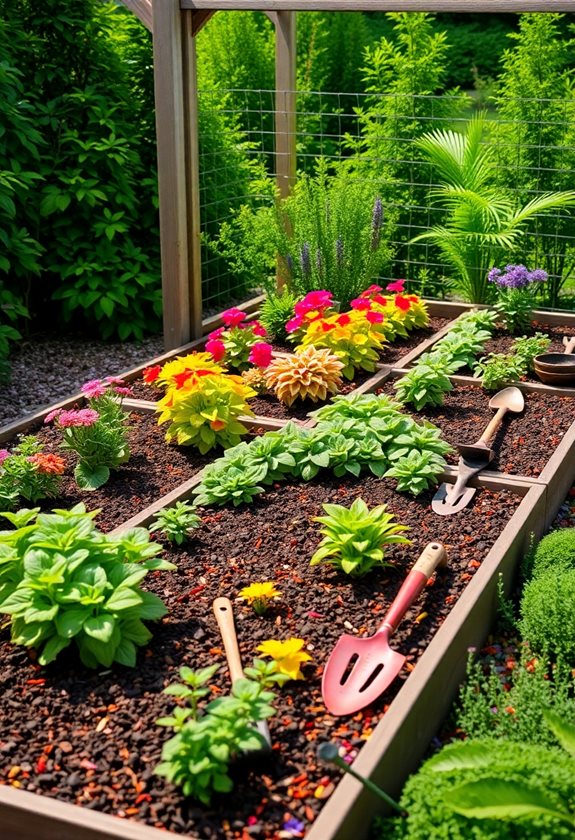
As the seasons shift, you might find yourself wondering what your garden needs to stay healthy and vibrant. Seasonal maintenance is key to a thriving garden! Here are four tasks to keep in mind:
- Prune your plants to encourage healthy growth and remove any dead branches.
- Check the soil for nutrients, adding compost if needed to boost health.
- Water wisely, ensuring your plants aren’t over or under-watered.
- Inspect for pests regularly—don’t let them crash the party! Additionally, consider following a seasonal planting guide to maximize your blooms throughout the year.
Frequently Asked Questions
What Are the Best Companion Plants for Enclosed Gardens?
When you’re choosing companion plants for your enclosed garden, think about those that enhance each other’s growth. For example, basil loves to hang out with tomatoes—it helps repel pests! You could also pair carrots with onions; they naturally deter each other’s pests. Plus, planting marigolds can brighten up your space while keeping unwanted bugs at bay. Isn’t it fun to see how nature works together? Happy planting!
How Do I Extend the Growing Season in My Enclosed Garden?
Imagine your garden as a cozy blanket, keeping your plants warm and snug. To extend your growing season, try these tips:
- Use row covers or cloches to shield plants from chilly nights.
- Opt for cold-hardy varieties like kale and spinach; they thrive in cooler temps!
- Consider adding a small space heater for those frosty evenings.
With a little creativity, your garden can flourish even when the frost tries to sneak in!
Can I Grow Vegetables Year-Round in an Enclosed Garden?
Absolutely, you can grow vegetables year-round in your enclosed garden! With the right setup, like using grow lights or heating mats, you’re golden. Consider these tips:
- Choose the right veggies: Leafy greens and root veggies thrive in cooler temps.
- Maintain humidity: A small humidifier can help.
- Monitor temperature: Keep it cozy!
What Tools Are Essential for Managing an Enclosed Garden?
To manage your enclosed garden effectively, you’ll need a few essential tools! A sturdy pair of gloves helps protect your hands from thorns and dirt. A trowel’s great for digging and planting, while pruners keep your plants tidy. Don’t forget a watering can—your plants will thank you! And a garden fork? It’s perfect for aerating the soil. With these tools, you’ll be ready to tackle any gardening challenge that comes your way! Happy gardening!
How Can I Attract Pollinators to My Enclosed Garden?
Imagine your garden as a cozy café, where buzzing bees and fluttering butterflies are your regulars. To attract these pollinators, you’ll want to serve them their favorite dishes! Start by planting bright flowers like sunflowers and lavender. Don’t forget to have a water source, maybe a shallow dish? Avoid pesticides; they’re like bouncers at your café! Invite them in with fragrant herbs, and soon, your garden will be alive with delightful visitors!



